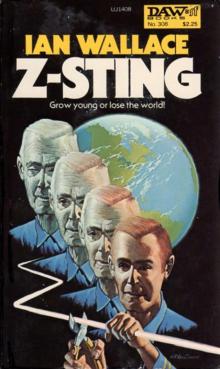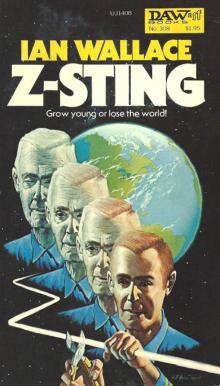- Home
- Ian Wallace
The Rape of The Sun Page 2
The Rape of The Sun Read online
Page 2
“Again, sir, I pause; your comments?”
Impatiently, J.C. asserted: “This has been an excellent review of what I know. But I think you are here to bring me something new.”
Sven was challenged. With my blood-pressure high, I watched and listened.
“I want to start with a couple of exhibits,” Sven began. “Dr. Sato, will you please do the honors? Thank you. What you see on the screen, sir, is what you think you see: a photograph of the sun in artificial eclipse so that only the flaring corona shows around the black disk. The temperature of this corona, as I’m sure you know, is nearly two million degrees Kelvin.”
“Indeed.”
“Now here is a direct photo of Sun, not in eclipse, taken by ordinary white light filtered-down to eliminate glare. Here is a second photo in ultraviolet. Here is a third in infrared. This fourth one filters out all except the powerful X-radiation; in this band of the spectrum, Sun is a highly variable star. Now, in quarter-split projection, all four pictures together.
“Each photo shows a different sun-surface and highlights different features. By the way, these photos were all taken by Mariner Nineteen at a distance of forty million kilometers, just inside Mercury orbit, using wide-angle holography. We aren’t equipped at this conference to project the holographs as such, which is a pity because they are spectacular—but spectacularity, in fact, is not what we really need here.”
“Captain, I couldn’t agree more. Go on.”
Sven, with alacrity: “As you know, the temperature of the
sun-surface is just under 6,000 degrees Kelvin. And every square centimeter of that surface is emitting 89,500 calories per minute. Not the little kilocalories which you count in your food, but full calories a thousand times hotter. A dime on the sun would catch nearly 214,000 calories per minute. Dr. Graben, how much ice did you say would melt in one minute on the sun?”
“A forty-foot thickness,” Hugo Graben responded. “Forgive the old foot-unit, it is more impressive; that translates to a thickness of twelve-point-two meters—melted in one minute on sun-surface.”
“My, my,” J.C. murmured. “Great energy source, at source. Too bad we aren’t there.” >
“Right,” Sven agreed. “Arid I think we should be there.” I wanted to applaud his opportunism.
J.C. digested the riposte which flagged the whole point of Sven’s daring proposal. J.C. queried: “You mean that we should be deeper into solar?”
“Yes, but more—I think you should be there” Sven pointed to the Sun photos.
J.C. was frowning, which might be encouraging; definitely it meant, “Go on, I’m listening.”
“Let me stretch this out a bit more,” said Sven, “just for the suspense. The trouble is, that the sun’s radiation-is going in all directions—and the farther away a planet is, the fewer of the sun’s photons it intercepts.”
“Goes down by inverse square, eh?”
“That principle, yes, but less rapidly, because the inverse square of the distance has to be modified upward by a constant to take care of overlap. For instance, take your projected solar field orbiting Earth at approximately earth-distance from Sun. Well, at this distance, those 89,500 calories per minute out of each square centimeter of the sun have diminished so astonishingly that the same dime, which gets 214 thousand calories per minute on the sun gets only five calories per minute at your field. But even that much is comparatively wonderful, because a hell of a lot less gets through the atmosphere to the solar panels on Helen’s house, without even considering the seasonal angles of the sun.”,
“Obviously,” J.C. quipped, “we must all be dead. Frozen stiff.” We all grinned, natch, and Sato tittered nervously. The chief raised a hand. “Don’t worry, of course I know that the heat builds up in our atmosphere and crust, and of course Earth has some internal temperature of her own. I don’t forget that Helen can energize her house with those weary little calories instead of using our fossil power, the renegade scamp! But your figures are useful, Captain Jensen, and I know that Helen wants you to pursue them.”
Sven pursued. “If we lived on Venus, which we can’t do, we’d be a lot better off for solar. Just outside the Venus atmosphere, that same dime would catch almost twice as many calories—about nine per minute.”
“Okay—”
“And if we lived on Mercury, which we can’t do, we’d be in great shape. A dime would catch thirty-two calories per minute, instead of our paltry five. Tell me, sir, am I far enough out for you to write me off?”
“Not yet,” said the chief, who was studying.
“Thank you. Next slide, please, Dr. Sato. As you see, this diagram of the sun and its inner three planetary orbits merely summarizes the information I’ve already related, but in a slightly different form. Forget Venus. As you see on the diagram, Earth receives 1.938 calories per square centimeter per minute in solar radiation; whereas Mercury’s calorie count is 12.9 per square centimeter per minute. In other words, a solar receptor on Mercury would be nearly seven times as efficient as the receptors in your earth-orbiting field. And I suggest that at such augmented efficiency, even a pilot program might immediately be profitable in terms of central reception and energy distribution.”
I was nodding slowly; Sven’s case was building with elegant suspense, and he hadn’t yet shot his wad. J.C. was thinking hard. Hugo Graben and Bob Mullett waited; their turns would come.
J.C. looked up. “I am waiting, Captain, for you to tell me how we bring 12.9 calories per square centimeter per minute a distance of ninety-two million kilometers from Mercury to Earth.”
“Instead, sir, let me raise the ante. Imagine a body orbiting the sun way inside Mercury-orbit, the distance from sun-surface being eight million kilometers, or 8.7 million from sun-center. That’s a distance out that is less than six times the diameter of Sun. On such an orbiting body, the reception of calories per minute by each square centimeter would be a whopping six hundred seventy-seven—which is nearly three hundred fifty times the solar reception at Earth. How would Southeastern Power like to have that piped into its back yard?”
Tall J.C. was on his feet. “Damn well!” he exploded, pacing. He stopped and wheeled on Sven: “But how in the hell are we going to do that?”
“In the eight million kilometer sun-orbit, you can position four satellites equipped with mirrors and lasers.”
“Oh, come, now! That close to the sun, any equipment we could send up would be incinerated—”
I interjected: “Why not sit down, J.C.? You can listen a lot better.”
He glared. He sat.
On Sven’s cue, Hugo Graben ponderously arose. “J.C., sir, Doctor Mullett and I have long been working on improvements to reentry heat shields, not only to replace the tiles on shuttles, but also for rocket boosters and capsules to improve their reusability. There is a concomitant use for us in connection with linings in our nuclear generators.
“I, sir, hit upon the idea that a perfect reflector would absorb no heat at all, but would reflect all of it, and consequently would never bum out. Naturally, we have not achieved and will not achieve perfection. We do, however, have a substance such that a film of it, with thickness adjusted to intensity of radiation, will reflect radiation at all wavelengths emitted by the sun with an efficiency that is an almost negligible fraction under one hundred percent.
“The substance is quite light. For adequate protection of a satellite orbiting Sun at eight million kilometers, the weight added by a coating of the substance would be acceptable in terms of launch from Earth. This includes crisis-protection from solar flares. I pause for questions.”
J.C., enormously impressed, sardonically said, “Since it is a mere pause, it follows that more is to come. Pray continue, Hugo.”
“Thank you, J.C., sir. Now I will go on and say that precisely the same substance can be used to coat a system of focusing mirrors which can be mounted on a system of satellites to direct the sun’s rays into a laser system beamed directly at some defined targe
t near Earth—beamed, for example, at the earth-orbiting receptor field which we are now constructing. Dr. Cavell tells us that it will not be difficult for her to work out the automatics of focusing and beaming.” I nodded.
“Of course,” Graben added, “there would be a certain amount of energy loss—” Sven and I could have murdered him.
“How much loss?” J.C. demanded, staring at Sven.
Bob Mullett intervened. “Captain Jensen has not deceived you, J.C. The energy loss en route to Earth, allowing for laser spread and all conversions, would not exceed ten percent—which still leaves us with more than three hundred times what we can get without the system.”
“Thank you, Doctor Mullett,” uttered Graben. “I was about to say that very thing. And now, sir, I have spoken my piece, and I turn it back to Captain Jensen.” Hugo sat.
Sven asked Mullett: “Anything to add, Bob?” Mullett said no. Sven and I waited, watching the chief.
J.C. was examining the table surface. At length he looked at Sven and said, “I have questions.”
“Of course.”
“First, why don’t we go in even closer—say five million kilometers out? I’d think that refrigeration would take care of the heat increment inside the satellites—and wouldn’t that double our calorie count?”
Sven said, “Hugo?”
“At that closer distance,” Graben asserted, “we’d get nearly three times as much radiation, without even considering solar flares. That might be a remote hope—we can work toward it—but it isn’t feasible now. Refrigeration wouldn’t handle it Our heat shielding would have to be augmented beyond an acceptable launch weight. Also, our gyroscopes couldn’t stabilize the satellites against solar turbulence. Anyhow, we do not have and cannot now create receptors capable of handling that much concentrated solar heat coming to Earth.”
“All right, I see that, it’s cogent,” the boss conceded. “Eight million kilometers, then—it gets us at Earth, what? better than six hundred calories per square centimeter per minute, allowing for efficiency loss—Bob, can our earth-orbiting solar field handle that?”
*Tm working on it with favorable results,” Mullett told us. “Production within a few months is feasible.”
“Okay. But, Captain—what if Mercury or Venus should interrupt the laser beams?”
“Venus won’t transmit Sun until 2004, and not again until 2012. Mercury transits come about thirteen times in a century, but the effects on this program will be negligible. Moon will rarely interrupt, because of the plane of your high-orbiting field. The beams will cut off during any planetary transit and then cut on again, automatically.”
“Well, then—how do you jazz up that frightening sun-orbital velocity of 444,000 kilometers per hour?”
“Nice offhand mental calculation, sir. I know I didn’t give you that figure, but it’s just about right. Anyhow, we can do it just by breaking loose from Earth’s gravitational field and then simply falling toward Sun, using power bursts at intervals for course corrections. I figure a bit over twenty-five days for the run—one way, that is.”
“And where do we get the sun-satellites?” J.C. wanted to know.
I answered that one. Looking at Smith, I said: “Correct me if I’m wrong, Ramsey. We have eight satellites now on line for communications purposes. Four of them can be pulled and adapted—”
Sven interrupted: “Sorry, Helen. Five.”
“Five?”
“One of those satellites on line, Helen, is oversize, intended to handle an enormous communications relay; but Ramsey tells me that the relay won’t be ready for about three years. I want that one diverted from communications into this project as a command vehicle with human crew.”
Vexed at Sven for throwing a curve ball past me in front of my chief and my production subordinate Ramsey Smith, I thrust: “Sven, you told me distinctly that the satellites could be entirely automated, unmanned.”
“I told you that on Wednesday, true, Helen. But I’ve done a lot more thinking since then and I’m sorry I couldn’t get to you earlier with this new conviction of mine which firmed up last night. This is the pilot project. There will be bugs that should be shot on site, s-i-t-e. We have got to put people up there on the first trip, in a fifth satellite for coordination of the others. Now that I’ve said it, Helen, I’m sure that you and J.C. can see it; and I confess that when I presented the project to you, I hadn’t seen it”
Slightly mollified, I turned to the chief—but not before noticing that Hugo Graben started to raise his hand, then jerked it back but continued to look disturbed.
J.C. ruminated. He turned to Sven: “Presumably you have costed-out the operation?”
“The pilot operation, yes.” Sven ran off a small number of major cost items with crude figures—“Subject,” he added, “as governments put it, to cost overruns.”
“The total,” I interjected, “represents a hefty expenditure—but, in view of futurities, worth the gamble, and well within our capabilities.”
J.C. remarked: “Your figures need checking, of course; but they seem about right, and I don’t imagine we want to involve other employees quite yet.”
I agreed. “Not except on fragment work. Not with overall knowledge.”
“If we should decide to do it, how soon could we do it?”
“Just about when we originally planned to launch our earth-orbiting field.”
That startled J.C. “Helen—you mean only seven months from now?”
“In August 1995, right. Why not? Our earth-orbiting field is practically built now, and Bob Mullett is close to a formula for a compound which will handle the more intense radiation. Our earthside receiving-transforming-distributing stations are on schedule for August activation. The vehicles are far enough along so that adaptation can start immediately; almost every component that will go into them is now in stock. Hugo Graben is ready to put Ramsey Smith into immediate production on the reflector shield substance—which, by the way, needs a name. Any suggestions, J.C.?”
“My first name is James. How about Jacobite?” Clearly the boss was had.
But he did not stay bemused long. “Captain Jensen,” he challenged, “there may be a conflict-of-interest problem. You, sir, are an employee of NASA. How can this be reconciled with your relationship to Southeastern Power on a profit-seeking solar thrust?”
Sven turned to me. “Tell him, Helen.”
Having swallowed, languidly I told my chief: “Sven has al-
ready resigned from NASA, he could not in good conscience have offered you this proposition otherwise. I suggest that we hire him as our mission coordinator and commander, and of course he is well positioned to handle our contacts with NASA in this capacity.”
“I buy it,” instantly said J.C. “Helen, you work out the details. For instance, how about the crew of that command capsule?”
With composure, I told him: “Although this hits me as a new thing, I envision a crew of five. Captain Jensen, of course, will command. Probably my husband Wei is obtainable as satellite coordinator, he has a genius for that sort of thing. That leaves two places to be selected.” Sven was watching me with galvanic interest.
J.C., frowning: “Helen, I know you've set me up for this . question, but—don’t you mean, three places to be selected?”
“Not when you consider, J.C., that of course I would go along as company commissar and systems bug-shooter.”
The chief stared. Then he elbowed his arms on the table and sank his face into his hands; between fingers he enunciated: “While you’re away in space, what’s your thought about who runs your division?”
My impulse was to answer, “Hugo Graben.” I looked at Hugo: he was eager-beaver hopeful. I looked at Bob Mullett and Ramsey Smith: both were diffident. I told J.C.: “Between now and then, we’ll come up with somebody.”
As the conference broke up, I confided to Sven: “I think Hugo has a reservation. Let’s go to my office.” I flagged Hugo, and the three of us departed, moving silently alon
g the corridor to my business pad.
I seated myself at my hypermagnitudinous executive desk; Sven stood behind me; Hugo, at my command, sank onto a sofa and looked unhappy.
I ordered: “Say it, Hugo.”
He went precise, it was his business attitude. “Helen, Captain Jensen, here is a problem that I see. Your unmanned satellites won’t have to come home; when their orbits decay, they can simply fall into the sun and be replaced. But, Captain—in your command capsule, how do you and your crew expect to escape from that fiendish gravity-well? If you’re closer in than eight million kilometers—how much closer, Captain?”
Sven told him, “Not much. Our command capsule will orbit roughly 300,000 kilometers inside the satellites, to avoid collisions in event of violent turbulence; that’s close enough for good telemetric checking. We will travel clockwise with Sun’s rotation to facilitate escape, while our satellites will travel counterclockwise. That way we’ll meet, check, and pass a satellite once in fifteen hours. Problem?”
“At 8.4 million kilometers from sun-center,” Graben announced, “your escape velocity would have to be over 162 kilometers per second—which is nearly 600,000 per hour. To get away from Sun, you’d need to carry along a cluster of about a dozen Saturn boosters. Is that or is that not a hell of a problem?”
This I hadn’t thought about! I turned to gaze up at Sven.
He was calm, of course. “Very good, Hugo. But don’t forget that our orbital velocity will already be 453,000 kph—so we need to boost that by only a bit over 130,000 in order to escape.”

 Megalomania
Megalomania Z-Sting (2475 CE)
Z-Sting (2475 CE) The World Asunder
The World Asunder Z-Sting
Z-Sting Lucifer Comet (2464 CE)
Lucifer Comet (2464 CE) A Voyage To Dari
A Voyage To Dari Pan Sagittarius (2509 CE)
Pan Sagittarius (2509 CE) The Rape of The Sun
The Rape of The Sun